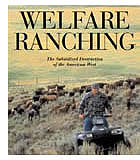by Paul Rogers, San Jose Mercury News
American taxpayers lose at least $128 million a year — and potentially up to $1 billion — subsidizing cattle grazing on millions of acres of public lands across the West, according to a new study commissioned by conservation groups.
The report, scheduled for release today by the Center for Biological Diversity and six other groups, underscores and extends some of the findings of a 1999 Mercury News investigation of federal grazing programs.
The conservation groups calculated that the average price in the West to rent private land to graze cattle is $13.10 a cow a month. But 23,600 western ranchers who rent federally owned forests, deserts and meadows from the U.S. Forest Service and the Bureau of Land Management pay barely one-tenth that, or $1.43 a cow a month.
Taxpayers also shoulder other costs, the report found.
AWR Advisory Board member George Wuerthner has just released a book “Welfare Ranching: The Subsidized Destruction of the American West.”
They pay to restore streams damaged by cattle. They pay to filter out giardia and other parasites that end up in city water supplies from cows. They pay to fence public campsites and archaeological sites.
And they pay for government trappers to kill mountain lions, coyotes and other predators that threaten cows on the public range. Nowhere does Uncle Sam account for the full cost, the report said.
“The lack of transparent accounting was the most frustrating thing,” said Karyn Moskowitz, a Rockefeller Fellow at the University of Kentucky and the main author of the report. “It was difficult to get a clear idea of just how much money the government is pumping into the federal grazing program to keep it going.”
Public land ranchers west of the Mississippi River provide just 3 percent of America’s beef. But a spokesman for the grazing industry said that figure understates their importance.
“When you look at small counties in the rural West, whole towns and school systems depend on ranching,” said Jason Campbell, federal lands director for the National Cattlemen’s Beef Association in Washington, D.C.
Campbell said fees are lower on public land because ranchers must provide their own water, cowboys and other costs that are covered when they lease private property.
The Forest Service and the BLM together manage about 320 million acres of public land in the West, of which 258 million acres, or 81 percent, are grazed by privately owned livestock.
In the past year, several environmental groups have increased efforts to buy out willing public land ranchers.
Since 1997, for example, the Grand Canyon Trust, based in Flagstaff, Ariz., has paid to remove cattle on 750,000 acres in the new Grand Staircase Escalante National Monument in Utah.
While ranchers and their supporters argue that they are just scraping by under the current system, the Mercury News investigation found that many of the grazing subsidies go to corporations and billionaires such as Idaho’s J.R. Simplot or Anheuser Busch.
